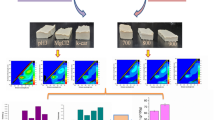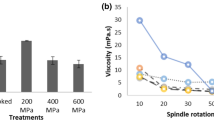Abstract
The aim of this study was to reduce the sodium chloride (NaCl) level in surimi-based products by adding lysine or cystine in combination with high hydrostatic pressure (HHP). For experiments, Alaska pollock surimi was used to prepare gels in a factorial design (3 × 3 × 2) using three additive levels (no additive, lysine, and cystine), three NaCl levels (0, 0.3, and 3 %), and two HHP levels (0 and 300 MPa/10 min/10 °C). After blending, the pastes, consisting of surimi, additives, and different levels of salt, were stuffed into casings, high pressure treated, and stored at 5 °C for 24 h (suwari gel). Subsequently, samples were heated at 90 °C for 30 min (kamaboko-type gel). To assess the degree of protein denaturation prior to gelation at 90 °C, suwari gels were analyzed by differential scanning calorimetry to determine myosin denaturation enthalpy. Kamaboko-type gels were characterized by lightness properties, water binding capacity, and mechanical properties (by puncture test). Results showed that the pressure treatment at 300 MPa and/or the addition of lysine or cystine (0 and 0.1 %) to low-sodium-chloride samples (0 and 0.3 %) resulted in gels with similar quality characteristics to those with the regular 3 % sodium chloride addition, most likely due to the protein unfolding induced by both HHP treatment and the additives used.



Similar content being viewed by others
References
AOAC. (2000). Official methods of analysis (17th ed.). Maryland: Association of Official. Analytical Chemistry.
Asghar, A., Samejima, K., & Vasui, T. (1985). Functionality of muscle proteins in gelation mechanisms of structured meat products. Critical Reviews in Food Science and Nutrition, 22, 27–106.
Ashie, I. N. A., & Lanier, T. C. (1999). High pressure effects on gelation of surimi and turkey breast muscle enhanced by microbial transglutaminase. Journal of Food Science, 64, 704–708.
Cando, D., Moreno, H. M., Tovar, C. A., Herranz, B., & Borderías, A. J. (2014). Effect of high pressure and/or temperature over gelation of isolated hake myofibrils. Food and Bioprocess Technology, 7, 3197–3207.
Cando, D., Herranz, B., Borderías, A. J., & Moreno, H. M. (2015). Effect of high pressure on reduced sodium chloride surimi gels. Food Hydrocolloids, 51, 176–187.
Cando, D., Herranz, B., Borderías, A. J., & Moreno, H. M. (2016). Different additives to enhance the gelation of surimi gel with reduced sodium content. Food Chemistry, 196, 791–799.
Carlez, A., Borderías, J., Dumay, E., & Cheftel, J. C. (1995). High pressure gelation of fish myofibrillar proteins. In E. Dickinson & D. Lorient (Eds.), Food macromolecules and colloids (pp. 400–409). Cambridge: Royal society of Chemistry.
Cheftel, J. C., & Culioli, J. (1997). Effects of high pressure on meat: a review. Meat Science, 46(3), 211–236.
Chen, W. L., Chow, C. J., & Ochiai, Y. (1999). Effects of some food additives on the gel-forming ability and color of milkfish meat paste. Fisheries Science, 65(5), 777–783.
Chung, Y. C., Gebrehiwot, A., Farkas, D. F., & Morrisey, M. T. (1994). Gelation of surimi by high hydrostatic pressure. Journal of Food Science, 59, 523–524.
Desmond, E. (2006). Reducing salt: a challenge for the meat industry. Meat Science, 74, 188–196.
European Food Safety Authority. (2005). EFSA provides advice on adverse effects of sodium. New and Events
Farkas, J., & Mohácsi-Farkas, C. (1996). Application of differential scanning calorimetry in food research and food quality assurance. Journal of Thermal Analysis, 47(6), 1787–1803.
Fernandez-Martín, F., Fernandez, P., Carballo, J., & Jimenez-Colmenero, F. (1997). High pressure-cooking of chicken meat batters protein behavior and product rheological properties. Journal of Agricultural and Food Chemistry, 45, 4440–4445.
Hamm, R. (1960). Biochemistry of meat hydration. Advances in Food Research, 10, 355–463.
Han, M. Y., Zhang, Y. J., Fei, Y., Xu, X. L., & Zhou, G. H. (2006). Effect of microbial transglutaminase on NMR relaxometry and microstructure of pork myofibrillar protein gel. European Food Research and Technology, 228, 665–670.
Kamath, G. G., Lanier, T. C., Foegeding, E. A., & Hamann, D. D. (1992). Non disulfide covalent cross-linking of myosin heavy chain in “setting” of Alaska Pollock and Atlantic croaker surimi. Journal of Food Biochemistry, 16, 151–172.
Kim, Y. S., & Park, J. W. (2008). Negative roles of salt in gelation properties of fish protein isolate. Food Chemistry, 73, C585–C588.
Lakshmanan, R., Parkinson, J. A., & Puggot, J. R. (2007). High-pressure processing and water-holding capacity of fresh and cold-smoked salmon (Salmo salar). Food Science and Technology, 40, 544–551.
Lanier, T. C., Yongsawatdigul, J., & Carvajal-Rondanelli, P. (2014). Surimi gelation chemistry. In J. W. Park (Ed.), Surimi and surimi seafood (pp. 101–140). Boca Ratón: CRC Press. Taylor and Francis Group.
Liu, R., Zhao, S. M., Xiong, S. B., Xie, B. J., & Liu, H. M. (2007). Studies on fish and pork paste gelation by dynamic rheology and circular dichroism. Journal of Food Science, 72(7), E399–E403.
Lund, M. N., Heinonen, M., Baron, C. P., & Estévez, M. (2011). Protein oxidation in muscle foods: a review. Molecular Nutrition and Food Research, 55, 83–95.
Macfarlane, J. J., & Mckenzie, I. J. (1976). Pressure-induced solubilization of myofibrillar proteins. Journal of Food Science, 41, 1442–1446.
Montero, P., & Gómez-Guillén, C. (2005). High-pressure applications on myosystems. In M. P. Cano, M. S. Tapia, & G. V. Barbosa-Canovas (Eds.), Novel food processing technologies (pp. 311–342). New York: CRC Press.
Moreno, H. M., Cardoso, C., Solas, M. T., & Borderías, A. J. (2009). Improvement of cold and thermally induced gelation of giant squid (Dosidicus gigas) surimi. Journal of Aquatic Food Product Technology, 18(4), 312–330.
NAOS Strategy. (2005). Spanish strategy for nutrition, physical activity and prevention of obesity. Spain: Minister of Health and Consumer Affairs.
Okamoto, M., Kawamura, Y., & Hayashi, R. (1990). Application of high pressure to food processing: textural comparison of pressure and heat induced gels of food proteins. Agricultural and Biological Chemistry, 54, 183–189.
Park, J. W. (2005). Surimi and surimi seafood (2nd ed.). Boca Raton: CRC Press.
Romero, A., Cordobés, F., Guerrero, A., & Puppo, M. C. (2014). Influence of protein concentration on the properties of crayfish protein isolated gels. International Journal of Food Properties, 17(2), 249–260.
Sato, K., Tanaka, C., Kotaru, M., Yoshikawa, H., Kawabata, M., Ikeuchi, T., Sato, K., Nakamura, Y., & Ohtsuki, K. (2001). Different arrangement of epsilon (gamma-glutamyl) lysine cross-linking in Alaska pollock (Theragra chalcogramma) surimi proteins by Streptoverticillium and endogenous transglutaminases during suwari process. Journal of Food Biochemistry, 25, 397–409.
Ting, H.Y., Ishizaki, S., & Tanaka, M. (1999). Epsilon-polylysine improves the quality of surimi products. Journal of muscle foods, 279–294.
Uresti, R. M., Velazquez, G., Ramírez, J. A., Vázquez, M., & Torres, J. A. (2004). Effect of high-pressure treatments on mechanical and functional properties of restructured products from arrowtooth flounder (Atheresthes stomias). Journal of the Science of Food and Agriculture, 84, 1741–1749.
Uresti, R. M., Velazquez, G., Vázquez, M., Ramírez, J. A., & Torres, J. A. (2006). Effects of combining microbial transglutaminase and high pressure processing treatments on the mechanical properties of heat-induced gels prepared from arrowtooth flounder (Atheresthes stomias). Food Chemistry, 94, 202–209.
Acknowledgments
This research was supported by the Spanish Ministry of Economy and Competitiveness and the Spanish National Research Council (CSIC) under the project AGL2011-24693 and the PhD student training program FPI 2012 (BES-2012-053420, Author Cando, D.). The authors would like to thank Dagbjørn Skipnes, Karin Tranøy, Laila Budal, Sigurd Øines, Lene Kramer, and Bjørn Tore Rotabakk for their excellent laboratory assistance.
Author information
Authors and Affiliations
Corresponding author
Rights and permissions
About this article
Cite this article
Cando, D., Moreno, H.M., Borderías, A.J. et al. Combined Effect of High Hydrostatic Pressure and Lysine or Cystine Addition in Low-Grade Surimi Gelation with Low Salt Content. Food Bioprocess Technol 9, 1391–1398 (2016). https://doi.org/10.1007/s11947-016-1728-8
Received:
Accepted:
Published:
Issue Date:
DOI: https://doi.org/10.1007/s11947-016-1728-8




